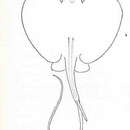Diagnostic Description
provided by Fishbase
Prominent triangular snout. Broadly rounded outer corners of disc. Upper surface brown or yellowish brown, paler toward margins of disc. Lower surface white (Ref. 6902). Few scapular spines. Middorsal row of spines present, but few on tail beyond pelvic fins (Ref. 7251).
- Recorder
- Arlene G. Sampang-Reyes
Life Cycle
provided by Fishbase
Exhibit ovoviparity (aplacental viviparity), with embryos feeding initially on yolk, then receiving additional nourishment from the mother by indirect absorption of uterine fluid enriched with mucus, fat or protein through specialised structures (Ref. 50449). Distinct pairing with embrace (Ref. 205).
Trophic Strategy
provided by Fishbase
Inhabits coastal waters, including estuaries and lagoons. Ascends rivers. Feeds on tube anemones, polychaete worms, small crustaceans, clams, and serpent stars.
- Recorder
- Drina Sta. Iglesia
Biology
provided by Fishbase
Adults inhabit coastal waters, including estuaries and lagoons (Ref. 12951) and ascend rivers (Ref. 12951). They feed on tube anemones, polychaete worms, small crustaceans, clams, and serpent stars (Ref. 12951). Ovoviviparous (Ref. 50449). Parturition occurs in July and August (Ref. 27549). Litters of 2-3 pups; gestation 4 months (Ref. 114953).
Importance
provided by Fishbase
fisheries: of no interest

